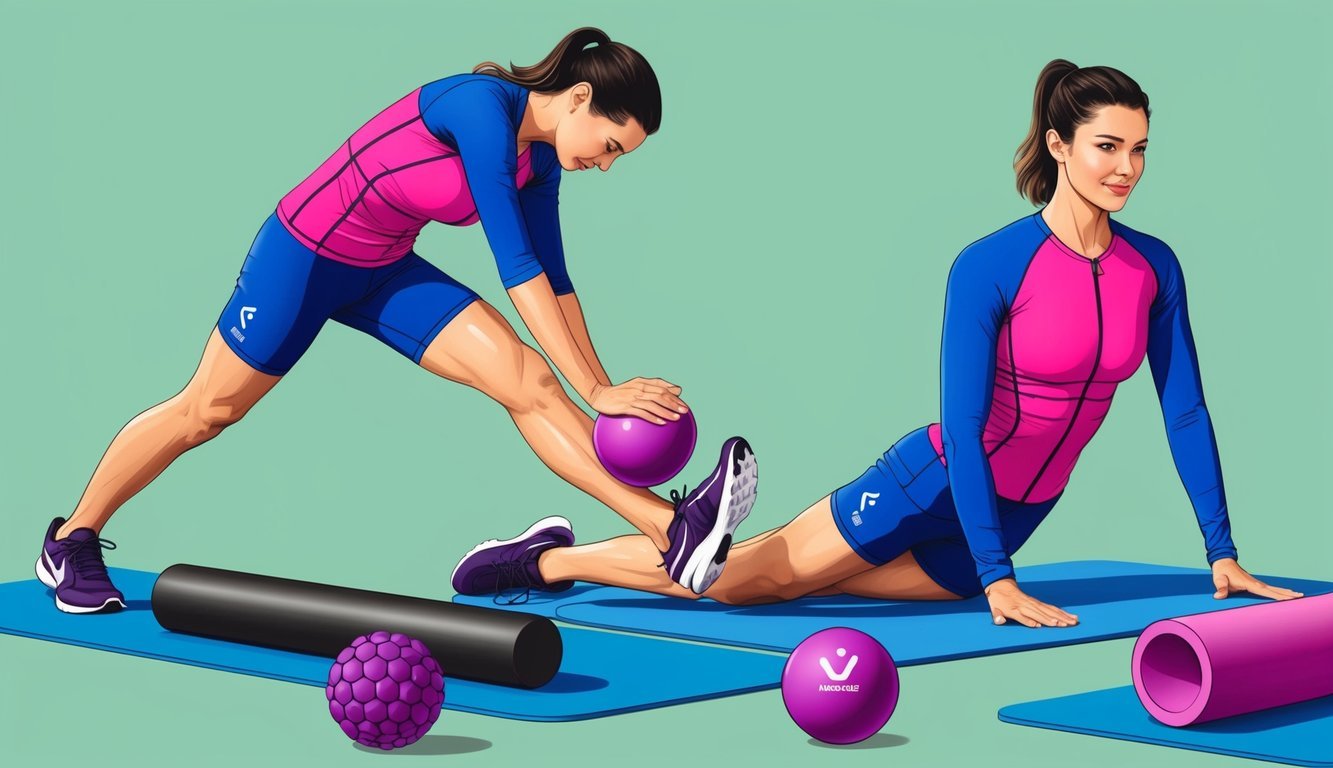After an intense workout, I often wonder how to recover quickly and effectively.
Recovering properly not only helps reduce soreness but also prepares me for the next training session.
It’s essential to give my muscles the care they need to bounce back stronger.

In this article, I’ll share seven proven tips that have helped me enhance my muscle recovery after exercise.
These strategies are based on practical ways to support my body, allowing me to stay on track with my fitness goals while minimizing downtime.
Foam Rolling
Foam rolling is a technique I use regularly for muscle recovery.
It helps relieve tightness and reduce soreness after workouts.
By applying pressure to specific muscle groups, I can enhance blood flow to those areas.
To get started, I simply lie down and position the foam roller under my sore muscles.
I focus on rolling slowly, about an inch per second, which allows me to pinpoint any tender spots.
When I find one, I stop and hold that position for about 20 to 30 seconds.
It’s important for me to roll up and down the length of the muscle, rather than side to side.
This method ensures a more effective release of tension in the muscle fibers.
I aim to spend about 10-15 minutes on this after my workouts for the best results.
Regular foam rolling has really boosted my recovery times.
It’s become an essential part of my routine that I don’t skip.
In my experience, the more consistent I am with it, the better I feel overall.
Icy-Hot Patches
Icy-Hot patches have become my go-to for muscle recovery.
They combine the cooling and warming effects of menthol and methyl salicylate, which help soothe my sore muscles.
When I apply the patch, I feel an immediate cooling sensation followed by warmth.
This dual action really helps dull the pain and ease any tightness I might have after a tough workout.
What I like most is the convenience.
I can stick one on after exercising and go about my day without worrying about messy creams or gels.
The patches provide steady relief for hours, which is great for keeping me comfortable.
Moreover, I appreciate the versatility.
Icy-Hot patches come in different sizes, making it easy to target specific areas.
Whether it’s my back, shoulders, or legs, there’s a patch that fits just right.
Incorporating Icy-Hot patches into my recovery routine has definitely made a difference.
They allow me to stay active while managing discomfort effectively.
3) Post-Workout Nutrition (e.g., chocolate milk)
After a workout, I know how important it is to refuel my body.
Nutrition plays a key role in muscle recovery.
One of my favorite options is chocolate milk.
Chocolate milk provides a good balance of carbohydrates and protein, making it great for recovery.
The typical 4:1 carbohydrate-to-protein ratio helps replenish glycogen stores and repair muscle tissue.
I usually drink it right after exercising.
Having it within an hour of my workout seems to maximize the benefits.
This drink not only satisfies my craving but also provides hydration and essential nutrients.
Plus, it’s a tasty treat that takes me back to childhood.
I’ve noticed that chocolate milk helps reduce muscle soreness for me.
It feels like a simple yet effective strategy to support my recovery routine.
Finding a delicious way to aid recovery makes all the hard work at the gym worth it.
Epsom Salt Baths

I find that Epsom salt baths can be a game changer for muscle recovery.
Epsom salt, which is magnesium sulfate, helps relax my muscles and reduce inflammation.
After intense workouts, soaking in warm water with Epsom salt can ease soreness.
I usually fill my tub with comfortably warm water and add about two cups of Epsom salt.
This makes a noticeable difference in how my body feels afterward.
It’s also a great way to wind down after a long day.
I take my time in the bath, letting the magnesium absorb into my skin, which helps me feel more relaxed.
The soothing effect extends beyond just my muscles; it helps relieve stress as well.
I aim to take Epsom salt baths a couple of times a week, especially after strenuous exercise.
It’s simple and effective for muscle recovery.
Plus, it transforms my bath time into a mini spa retreat.
5) Compression Clothing

I’ve found compression clothing to be pretty helpful for muscle recovery.
These garments fit snugly and can provide a gentle pressure that supports circulation.
Better circulation means more oxygen and nutrients reach my muscles, which is essential after a tough workout.
Wearing these clothes has also helped reduce soreness.
Many athletes, including myself, swear by them for making recovery feel quicker and easier.
It’s like giving my muscles a little extra help when they need it most.
Additionally, compression clothing can improve my proprioception.
This means I’m more aware of my body’s movements, which can enhance my workout performance.
Choosing the right type can be a game-winner for both recovery and subsequent training sessions.
I like to wear them during my workouts and even afterward.
Whether I’m running or lifting weights, they seem to make a noticeable difference in how I feel.
If you haven’t tried them yet, they might just be worth a shot.
6) Proper Sleep

Sleep is crucial for muscle recovery after a workout.
It’s during sleep that my body gets the chance to repair itself, thanks to growth hormone, which kicks in during deep sleep.
This hormone plays a big role in repairing muscle tissues damaged during exercise.
I always aim for 7 to 9 hours of quality sleep each night.
This timeframe allows my muscles to recover fully and helps prevent injuries.
I notice that the more consistent my sleep schedule is, the better I feel during workouts.
Creating a relaxing bedtime routine is also key.
I find that practices like winding down with a book or some light stretching help signal to my body that it’s time to sleep.
Avoiding screens an hour before bed has really improved my sleep quality too.
Don’t underestimate the power of good sleep hygiene.
A dark, cool room can significantly enhance my ability to fall and stay asleep.
Prioritizing sleep helps me feel energized and ready to tackle my next workout.
7) Active Recovery (e.g., light yoga)

Active recovery has become a favorite of mine when it comes to enhancing muscle recovery.
Instead of just sitting around, I engage in low-intensity activities like light yoga or a gentle walk.
This helps keep my blood flowing, which is crucial for muscle repair.
I often turn to yoga after a tough workout.
It’s a great way to stretch out and relieve any tension in my muscles.
The movements are calming, and they help to improve flexibility, which I sometimes overlook during intense training sessions.
Another bonus is that active recovery can reduce inflammation.
By moving my body, I help flush out the waste products built up during exercise.
It feels good to know I’m actively supporting my recovery instead of just waiting for my muscles to heal on their own.
Incorporating active recovery into my routine has made a noticeable difference.
Whether it’s a quick yoga session or an easy swim, I always feel more refreshed and ready for my next workout.
Understanding Muscle Recovery

Muscle recovery is an essential component of any workout routine.
I find that understanding the biology behind it and its importance can really help enhance my recovery process.
The Science Behind It
Muscle recovery occurs primarily after exercise-induced stress.
When I work out, particularly with resistance training, small tears happen in my muscle fibers.
This process, known as microtrauma, is what leads to muscle soreness.
After a workout, my body enters a repair mode.
During this phase, satellite cells activate and help repair these tears.
Additionally, protein synthesis kicks in, which is crucial for muscle growth and recovery.
I make sure to consume adequate protein, as this is where amino acids come in.
They provide the building blocks my muscles need for repair.
Hydration is also key; my body requires fluids to facilitate nutrient transport and recovery.
Why It Matters
Understanding muscle recovery is vital for a few reasons.
First, it helps me prevent injuries.
When my muscles are not allowed to recover properly, I increase the risk of strains and other injuries.
Secondly, prioritizing recovery leads to improved performance.
I notice that when I give my muscles time to heal, I come back stronger and more energized for my next workout.
Lastly, mental well-being plays a role.
A well-structured recovery routine helps reduce stress and fosters a more positive attitude toward exercise.
Whether it’s through stretching, hydration, or proper nutrition, investing time in recovery pays off in my fitness journey.
The Role of Nutrition in Recovery

Nutrition plays a crucial role in muscle recovery after exercise.
The right balance of nutrients and hydration can significantly enhance my recovery process, helping to repair muscle tissue and restore energy levels.
Consuming protein and carbohydrates shortly after a workout supports muscle repair and replenishes glycogen stores.
Staying hydrated and including vitamins and minerals in my diet are also essential nutritional strategies that aid in reducing inflammation and promoting faster recovery.
By prioritizing these strategies, I can optimize my performance and overall well-being.
Key Nutrients for Muscle Repair
To support muscle repair, I focus on two main nutrients: proteins and carbohydrates.
-
Proteins: After exercise, my muscles need protein to help rebuild and repair tissue. Aim for sources like chicken, fish, eggs, or plant-based options such as lentils and quinoa. Aiming for about 20-30 grams of protein within 30 minutes post-workout is ideal.
-
Carbohydrates: Carbs are essential for replenishing glycogen stores that fuel my workouts. Foods like brown rice, whole grain bread, and fruits can be excellent choices. Consuming sugar can speed up recovery, especially if workouts are intense and back-to-back.
Incorporating a mix of both ensures I recover quicker and come back stronger.
Hydration and Its Impact
Staying hydrated is another game-changer for my recovery.
When I exercise, I lose fluids through sweat, which can lead to dehydration.
A rule of thumb I follow is to drink approximately 1.5 liters of water for every kilogram of body weight lost during exercise.
This translates to about 3 cups of fluid for every pound lost.
Dehydration can affect muscle function and delay recovery.
I like to add electrolytes to my drinks, especially after long or intense workouts, to maintain my body’s balance.
Keeping track of my hydration levels not only improves my recovery but also prepares me for my next workout.

